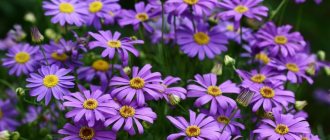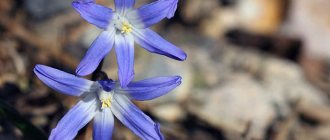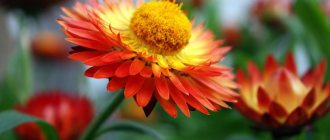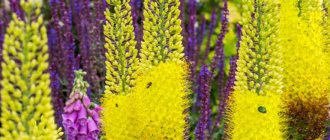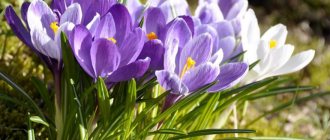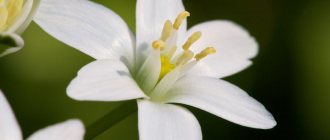Euphorbia will forgive the gardener even the greatest negligence and forgetfulness. These decorative succulents can be grown at home in pots and garden beds. They are distinguished by remarkable species variability, so it is not difficult to find a variety that will fully satisfy our aesthetic requirements. Some ornamental species grow in gardens, others are weeds. Find out how to grow perennial garden spurge - planting and care, plant propagation.
Description of the plant
There are about 2 thousand species of plants in the genus Euphorbia in the world, belonging to the Euphorbia family of the same name. The vast majority are heat-loving succulents, shrubs and trees found in Africa. But in our country you can find more than 20 wild species.
It is difficult to characterize Euphorbia and describe the botanical characteristics of the genus, because its species are diverse, some resemble meadow perennials, others resemble exotic cacti. Among them there are annual, biennial, and perennial plants. The height reaches from several tens of centimeters to 1.5 meters!
The only common feature of all species is the unusual inflorescence, which consists of a nondescript flower containing one stamen and one pistil, surrounded by colorful and beautiful leaves that are often confused with flowers. They take on shades ranging from neutral greens and yellows to reds and oranges and last for months. The humble flowers have the ability to lure winged insects.
There are some dangers to milkweed in the wild and garden that you need to be aware of. Its stems and leaves contain milky sap, a highly toxic substance previously used in folk medicine to treat warts and freckles, but it poses a serious health hazard.
Euphorbic acid, rubber and cyanogenic compounds present in the milky sap cause changes in the skin, including blisters, ulcers, and can cause temporary blindness if it gets into the eye. The result of ingestion is vomiting and diarrhea. The plant should not be within the reach of small children! Adult gardeners should wear protective gloves for any job. Be careful not to get the juice into your mouth, nose or eyes.
Attention! People who are allergic to latex should take special care when coming into contact with milkweed.
Garden spurge: types, photos and names
From almost 2000 varieties, every gardener will be able to choose a plant to their liking. Among the most popular ones used for garden decoration are the following.
Multiflora or polyflorum (Euphorbia epithymoides)
The natural habitat of this species is the mountainous regions of Europe. The perennial plant in the process of development forms a beautiful rounded crown of the correct shape, which, with a bush height of 0.5 to 0.7 m, creates an attractive picture.
The basal leaves are scaly, they form a rosette; the same ones that are located on the stem, round in shape. The leaf-spreads are painted in a light yellow tone, which acquires a beautiful orange color at the time of flowering. The flowering period takes a little more than a month, occurring in May – June.
Almond (Euphorbia amygdaloides)
A fairly large perennial, whose height can reach 0.7 m. Moreover, the underground part, represented by a horizontal woody root, often coincides in size with the above-ground part.
In the first year of life, the bush produces vertically oriented shoots, which become woody over time. They are densely covered with petiolate dark green leaf plates of an elongated elliptical shape.
The apical rosette of leaves overwinters on the bush, and the next year small shoots appear from it, covered with sessile greenish-yellow leaves framing the peduncles.
Flowering occurs in April - May.
Cypress (Euphorbia cyparissias)
A low (up to 0.4 meters) variety of milkweed with erect shoots, densely covered with needle-like leaves. As it grows, it forms dense clumps.
A notable feature of the plant is its ability to re-bloom : the first wave occurs in May, the second at the beginning of autumn. When flowering it spreads a pleasant aroma.
The petals-spreads of some varieties may have a delicate pink color, but in most plants they have a purple or burgundy tint.
Marginata (Euphorbia marginata)
Grown as an annual, it is distinguished by well-branched, vertically oriented shoots, whose height can reach 0.8 m.
The shoots are densely covered with light green, fairly large (up to 4 cm in length) oval-shaped leaf plates. The arrangement of leaves can be alternate or whorled.
The bush is characterized by long flowering , which lasts from July to mid-September. At this time, the apical leaf plates of garden milkweed receive a bright white border, and the bedspreads surrounding the inflorescence turn completely white.
Myrtle leaf (Euphorbia myrsynites)
This plant is simply irreplaceable when decorating rocky areas or alpine hills. The fleshy creeping stems are not too tall, their length is only about 0.2 m. The shoots form rosettes.
On the stems there are a large number of medium-sized leaf blades of an obovate shape with a remarkable greenish-blue color.
At the top of each shoot, capitate inflorescences are formed . The leaves that form the blanket are tightly curled around the flower and vaguely resemble a rose with greenish-yellow petals.
The flowering period takes all of May and most of June, but in warm springs flowering can begin in April. The plant reproduces well by self-seeding; this must be kept in mind when planting.
Capitulata (Euphorbia capitulata)
An interesting compact variety. Prefers rocky, well-lit areas. The height of the shoots is about 0.1 m. The flowering period occurs at the end of spring, and at this time capitate spurge becomes an expressive decoration of the site.
Stone-loving (Euphorbia petrophila)
A herbaceous perennial plant whose shoots at the base become woody over time. The color of the stems has a reddish or brownish tone. The height of the shoots does not exceed 0.2 m.
Foliage from previous years leaves scar marks on the stems, which can be used to approximately determine the age of the plant.
The leaf blades have an elongated elliptical shape, about 2 cm in length, and are distinguished by the presence of a serrated edge. The color of the foliage is greenish-gray, the integument is leathery, and the leaves themselves are quite dense.
Flowering occurs at the end of May and lasts until the beginning of July. The inflorescences are wrapped in burgundy egg-shaped blankets ; they are formed by 3–5 flowers.
Swamp (Euphorbia palustris)
The color of the erect long shoots, reaching a meter in length, is noteworthy - it is burgundy.
There is a lot of foliage on the shoots; it is rich green with a noticeable light cream longitudinal vein. The flowering period occurs at the end of May, at which time the plant forms fiery yellow inflorescences.
Chin or caper (Euphorbia lathyris)
This variety has a two-year life cycle and quite impressive growth (up to 1.5 m). The plant is suitable for areas located in light shade.
In the first year of life, milkweed produces an erect shoot, distinguished by a reddish color. In the second year it forms flowers and dies after flowering. The variety reproduces well by self-sowing.
Vegetable garden (Euphorbia peplus)
Since this variety is completely undemanding to soil quality and instantly reproduces by self-sowing, it is often pulled out as a weed.
But a certain decorative quality is still inherent in the low bush. And if you monitor the growing season of the plant, and immediately remove the corollas after flowering, then garden spurge may well be present on the site.
Griffith or fire (Euphorbia griffithii)
This large (up to 0.8 m in height) plant is a striking example of highly decorative milkweed. Its vertical shoots form a rounded bush and are densely covered with elongated leaf blades with a bright longitudinal stripe on each.
During the flowering period, inflorescences with red, orange or yellow petals appear on the shoots.
Cornigera (Euphorbia cornigera)
Not too bright, but an atmospheric plant, whose bush is formed by erect shoots up to 0.8 m long. The flowering period occurs in the second half of summer.
The plant forms inflorescences of horny greenish-yellow flowers. The leaves are elongated-lanceolate, dark green, with a noticeable light stripe in the center.
Schilling's (Euphorbia schillingii)
A tall bush can reach 1 m in height and serves as an excellent background for flowering perennials without overwhelming them with its blooms.
The color of the petals is yellowish-green, but not too bright. The leaf blades are elliptical in shape, rich green in color, and are distinguished by a noticeable longitudinal stripe.
Mediterranean or sculptured (Euphorbia characias)
It is distinguished by its large bush size (up to 1.5 m), early and long flowering. During the flowering period, the bush is abundantly covered with inflorescences-tassels of light green color. The bluish-green leaves have a beautiful elongated shape.
Altai (Euphorbia altaica)
A herbaceous perennial whose height does not exceed 0.2 m. The shoots do not branch; they are divided into generative and vegetative.
The shape and size of the leaves vary: at the base of the shoot they are ovoid and medium-sized (about 3 mm), at the top of the shoot the length of the leaf can already reach 3 cm, and its shape takes on an elongated oval shape.
During the flowering period, yellow-green umbrella inflorescences with a wide bell-shaped leaf-spread appear on the tops of the shoots.
Rocky (Euphorbia rupestris)
A low bush, whose vertical shoots do not exceed a height of 0.2 m. There are few leaves on the shoots, thanks to which the openwork shape of the bush .
The leaf plates themselves are very beautiful; they constitute the main decorative value. The leaf length can reach 4 cm with a width of 1.5 cm; they are painted in a bluish tone, but have bright white veins.
Scaly (Euphorbia squamosa)
This spurge attracts attention with the correct spherical shape of the bush. The height of the plant reaches 0.4 m. Oval light green leaves and yellow inflorescences complete the picture.
Soil requirements
Euphorbia is grown in well-drained soil in full sun. Some species can grow in light shade during the day. Grown as an ornamental plant, almond milkweed (Euphorbia amygdaloides) grows in semi-shady areas.
Some species, such as Euphorbia palustri, prefer a fairly moist substrate, but most prefer dry or moderately moist, well-drained soil. M. Griffith is more demanding, requiring humus, moist, acidic soil.
These extremely tolerant plants grow well in most soil types, including dry, sandy soils. Only loamy soils are not suitable for all species. The ideal soil reaction should be slightly acidic, possibly neutral.
For milkweed in pots, it is better to purchase a special mixture of substrate for cacti and succulents.
When buying milkweed, it is better to learn about the needs of a particular species. The closer we select a planting site according to the conditions that are natural for a particular species, the better the plant will grow.
Benefits and Applications
- Indoor spurge is a rather beautiful plant, so it is often used for decorative purposes.
- Euphorbia is a rubber-bearing plant with tanning properties (though this quality is not much used in industry, but the natives used this property for their needs).
- Euphorbia juice, although poisonous, is used in small doses to treat certain types of diseases.
At home
- Euphorbia is unpretentious and hardy. Perfect for those housewives who forget to water their flowers.
- Euphorbia is used for landscaping classrooms, offices and other institutions. Due to the fact that all types of milkweed can grow quite quickly and up to 1-2 m, they fit perfectly into the office space.
- Euphorbia can also be grown in gardens.
In medicine
- The juice is used as a base for medicines.
- Euphorbia juice has analgesic, anti-inflammatory and antipyretic properties.
Landing
Most types of milkweed can be sown as seedlings in pots at home. In garden stores you can buy small seedlings that grow to impressive sizes when planted. Euphorbia is planted in open ground so that it has a lot of space around it, even if it does not look attractive at first. Euphorbia seedlings are planted in open ground when the risk of frost has passed (from mid-May). You can start growing at home at almost any time, although in winter most species go into hibernation and are best left alone.
Euphorbia tends to grow in all directions, which is not a problem; the shoots can be pruned at will at any time.
A few words about milkweed
“The high decorativeness and unpretentiousness of indoor euphorbia species makes it possible to grow them not only in apartment conditions, but also to use them in landscape design.”
These magnificent succulents brought us the subtropics. Their biological homeland: Africa, America, Madagascar. Euphorbia (the second name for milkweed) may look like:
- tree;
- flower;
- bush.
Despite the abundance of natural forms, and their sometimes complete dissimilarity with each other, all types of euphorbias in the photo with names have one characteristic feature - they produce milky juice. The liquid is aggressive and unsafe. Its chemical composition contains toxic euphorbine. The substance irritates mucous membranes and causes burns, so you need to care for the plant carefully.
The milky sap of milkweed is poisonous
However, this moment is not a reason to draw hasty conclusions about the harm and, especially, the danger of every indoor milkweed flower seen in the photo. You may not even suspect that this particular species is produced on an industrial scale for the needs of folk and traditional medicine and cosmetology.
But let's return to our floriculture topic. The high decorativeness and unpretentiousness of indoor euphorbia species allows them to be grown not only in apartment conditions, but also to be used in landscape design. Both cases have their own nuances.
Growing and care
Euphorbia will grow well without care. In the case of the Cypress species, its expansion should be limited. Euphorbia myrtifolia should be covered for the winter, it can freeze, and capitate prefers a more drained substrate.
Watering
Some euphorbias are succulents that can perfectly store water in their shoots. All species are drought-resistant and require relatively little moisture. Therefore, garden spurges do not need to be watered at all, but potted spurges need to be watered from spring until autumn, when the top few centimeters of the soil become quite dry.
In winter, water only when the plant seems slightly wilted.
Fertilizer
Milkweed is fertilized occasionally. You should think about them only when the lower leaves begin to noticeably turn yellow. Apply low doses of water-soluble fertilizer. As a rule, indoor plants require more nutrition than those growing in open ground; for garden milkweed, it is enough to add a handful of compost to the soil when planting.
Wintering, care in autumn
The frost resistance of milkweed varieties is very different, but perennial species, such as the well-known owner of pretty yellow flowers - Euphorbia multiflora (E. polychroma) tolerate even severe frosts well and do not require much protection for the winter. All types in the fall need to be covered with a small shelter - a layer of several centimeters; you can use spruce branches, bark, sawdust, leaves.
During winter thaws and early spring, evergreen species of milkweed should be protected from direct sunlight.
Where and how does it grow
The homeland of milkweed has not been determined. This plant grows in a free range throughout the globe, especially in the continental and subtropical zones. Many indoor species have appeared in Madagascar, South America and Africa. There are species that grow in nature in Europe and Asia, even in our latitudes (but they are rather weeds, and only a few species are cultivated and grown in gardens).
Under what conditions does spurge grow?
- Temperature conditions. The plant is quite accustomed to temperature changes. Under natural conditions, it grows where the temperature difference between night and day is more than 10-15˚C.
- Illumination. In a subtropical climate, daylight hours last for at least 10 hours, which is what those types of milkweed that most often grow in our apartments are accustomed to.
- The soil. Most often sandy or well-drained.
- Water. The plant quickly accumulates moisture during heavy rains and calmly endures periods of the most severe drought.
- Lifespan. It can be either an annual or perennial plant. Indoor specimens live for 10 years.
Reproduction
Euphorbia reproduces well on its own - new seedlings usually appear around the mother plant, which can be dug up and transplanted to the chosen location.
Propagation of milkweed by cuttings (shoots, roots) brings good results. To do this, cut off a piece of the stem or one of the shoots, place it in a peat substrate and keep it in light moisture, periodically lightly spraying water from a spray bottle. The box with cuttings must be covered with film to maintain high air humidity inside. The film must be removed and the seedlings ventilated once a day to prevent mold from appearing. When new green shoots appear and the seedlings take root, you can transplant them into a separate container.
How to deal with it?
Attention! In the spring, the period of combating milkweed begins. And, unlike other weeds, it requires a special approach.
There are two main ways to control the plant:
- mechanical;
- chemical.
It is more effective to use two methods in combination. In the fight against grass, gardeners have learned to use folk remedies (for example, boiling water or decoctions) and modern drugs. Sometimes you have to expect results within 1-2 years.
It is not recommended to cut grass with a mower. All roots will remain in the soil and will soon make themselves felt. By the way, mowing has a beneficial effect on ordinary grass; its root system is only further strengthened. Over time, the plant begins to capture new territories.
Diseases, pests
A high level of humidity in the soil and air contributes to the development of fungal diseases in milkweed, so plants should be watered moderately, planted in ventilated places, and house plants should be planted in well-ventilated areas.
Euphorbia is resistant to most pests - few animals crave contact with its toxic milky sap or sharp leaves. Sometimes mealy bugs and spider mites are found on plants, which readily feed on the leaves, weakening them and slowly killing them. They have alarming reproduction rates, so early intervention is critical to saving the plants. The best means of combating these unwanted guests are considered to be special insecticidal preparations or aromatic oils.
Euphorbia - medicinal properties
Euphorbia has tonic, blood purifying and stimulating properties. In addition, it has been proven to be an excellent laxative. This plant is prescribed for peptic ulcers, tumors and ailments of the gastrointestinal tract. The juice of the herb is used to destroy calluses and warts, as well as various spots on the face. Powder from the root can be sprinkled on boils, ulcers and burns.
Euphorbia roots are considered medicinal raw materials, as they contain:
- alkaloids;
- toxins;
- lactones;
- phytosteroids;
- glycosides;
- a large amount of selenium (also found in the above-ground part);
- tannins and bitter extractives;
- saponins;
- vitamin C;
- euphorbic acid;
- amorphous gum;
- triterpenoid and diterpenoid compounds;
- water and water-soluble substances.
The milky juice has a diaphoretic, diuretic, analgesic, anti-inflammatory and anthelmintic effect on the human body.
Infusions, decoctions and root extracts have the following effects on the body:
- wound healing;
- regenerating;
- improves blood circulation;
- immunostimulating;
- anti-inflammatory;
- antifungal;
- antibacterial;
- laxative;
- cardiotonic;
- antispasmodic;
- exciting.
In ancient times, milkweed was used to treat paralysis, insect bites, swelling and extensive wounds that did not heal for a long time.
Use in the garden
Euphorbias are mainly grown as indoor plants, which forgive the owner the usual forgetfulness. They look great on window sills and well-lit shelves. In the summer season, they can be taken out to the balcony or terrace, where they will create an aura of exoticism.
In the garden, milkweed grows well on rocky rocks, elevated flower beds, and ideally on sloping terrain.
Euphorbia can be combined with the following plants:
- sedums,
- girl's tansy,
- series,
- tulips,
- bush bulbina,
- mesembryanthemum.
Euphorbia myrtifolia grows well in sunny flower beds, in rock gardens, and on permeable substrate. Cypress species (Euphorbia cyparissias) and Euphorbia seguieriana (Euphorbia seguieriana) grow well in dry areas.
In general, milkweed is an ideal plant for beginning gardeners; it is easier to damage with too much care than without it. It is only important to choose a species that suits your aesthetic requirements and growing conditions, and if proper care is taken, the plant will become a wonderful addition to the garden.
Does it harm neighboring plants?
Due to its powerful root system, spurge can have a detrimental effect on surrounding plants. Thus, strong lateral shoots on the rhizome can intertwine with the tubers of neighbors, taking away nutrients and moisture from them. All other things being equal, on a plot of land, spurge is able to grow and take over almost the entire plot, while other crops will gradually begin to die out and succumb to the aggressor.
It causes the greatest harm to grain crops; the latter can completely lose their ability to grow and function normally. This proximity definitely leads to diseases and death of many crops.
But despite such bleak descriptions, spurge often becomes the only indicator of soil condition. If spurge feels great on your site, this indicates soil fertility.
Most of us are accustomed to treating milkweed as one of the main green pests, but it should not be underestimated. Even in the old days, they did not try to completely get rid of the grass, but used it for good purposes - they scared away rats and mice with it, hung it in some places in the house to get rid of bedbugs and cockroaches.
Wild spurge cannot be grown indoors, but a special plant variety has been bred for this purpose. But self-medication with milkweed is absolutely forbidden. This can have serious consequences (you can confuse the dosage).
Pests and their control
| Pests | Signs | Prevention | Treatment |
| Nematode | Dry brown spots; Drying and curling of leaves; Suppressed growth. | Burning all weeds on the site; Disinfection of soil and seeds; Spilling boiling water on the soil; Regular weeding and loosening. | Soaking the roots of the plant in hot water with formaldehyde; The use of nematicides - chemical or biological products. |
| Mealybug | Cotton-like waxy coating; Black sooty mushroom. | Regular inspection of plants; Removing dry leaves. | Washing with a solution of laundry soap; Treatment with infusion of garlic or tobacco; Use of drugs: Aktara, Calypso, Fitoverm. |
Euphorbia cactus in the interior
The home flower euphorbia has an unusual and very decorative appearance. Not everyone is scared off by its poisonous juice; the spurge cactus can also bring benefits to the owner of a house or apartment. The succulent purifies the air in the room and kills harmful microorganisms. The cactus plant is a tall spurge, so it is best to keep it in non-residential areas. Succulents can often be found in offices. Simple care of euphorbia also affects the popularity of the flower.
You should not place it in the bedroom, because the subtle aroma of the plant leads to sleep disturbances and insomnia. The succulent looks good in arrangements with other potted flowers that have the same stem color as milkweed. It goes well with scarlet and Kalanchoe. Decorative pots emphasize the ascetic beauty of the plant, making it a real decoration of the room.
Options for using milkweed in the interior:
- Large specimens can be installed in any room alone or in groups.
- Cacti are appropriate both for floor placement and on tables, cabinets, and stands.
- Bright green spurge looks organic on both dark and light backgrounds.
Is it possible to achieve buds at home?
Yes, it's possible. The flower is often used for landscaping indoors and summer cottages. Euphorbia received its name due to the content of milky juice in the stems, which is poisonous. Therefore, you should be careful when growing this plant.
How to force it to open up?
- Sufficient lighting. All plants need sunlight. Do not allow direct rays to hit the plant, otherwise a burn may occur. The ideal place for the pot would be a window sill on the south side of the house.
- Regular watering. You should not allow excess moisture, but you should not allow drought either. The larger the milkweed leaves, the more frequent watering is recommended.
- Transfer. It is worth taking soil for succulents.
It contains peat, humus and river sand. It is better to replant young plants every year, and adults once every two to three years. Important! When transplanting, be sure to wear gloves and wash your hands with soap upon completion to avoid getting the poisonous juice on your mucous membranes and skin. - Good fertilizer. All plants will benefit from potassium, but the choice of fertilizer should be selected based on the specific type of plant. Fertilizers for cacti are allowed.
- Pruning. If the plant quickly grows in height and width, the shoots should be trimmed. With the exception of those that may bloom in the near future, since the loss of a large shoot can adversely affect the plant. After major pruning, the plant may not bloom in the next year - this is normal.
- Optimal temperature. Euphorbia is a heat-loving plant. The best option for milkweed to stay is a balcony in the summer, with the exception of cool days.
Signs of blossoming
Most euphorbias bloom with small, inconspicuous-looking flowers of yellow-green color. After a month of flowering, a dormant period begins, which differs in care.
Diseases and their treatment
| Disease | Signs | Prevention | Control measures |
| Fusarium | The leaves turn yellow and wither; A dark ring is visible on the cut; White or reddish coating on the root collar; Drying of the aboveground part of the bush. | Liming acidic soil; Moderate watering; Good drainage layer; Loosening and mulching; destruction of insect carriers; proper care. | Removal of affected parts; Replanting to a new location with healthy soil; Treatment with biological products and fungicides (Fitosporin, Fitolavin, Bordeaux mixture and others). |
| Root rot | Slow growth; Darkening of the stem; Brown spots on leaves; Drying of foliage and lodging of stems. | Calcination and disinfection of seeds before planting; Disinfection of equipment, burning of affected plants (they cannot be left in compost); Compliance with agricultural practices (proper watering and fertilizing). | Removing the damaged part of the bush, replanting it in a disinfected substrate; Treatment with drugs: Trichodermin, Trichofit, Mikosan, Discor, Copper sulfate, Vitaros. |
| Ring spot | Yellow ring-shaped spots on the leaves. | Destruction of vectors – nematodes; Disinfection of seeds, soil and garden tools | This viral disease has no cure. Affected plants should be burned. To prevent large-scale spread in the area, it is necessary to treat the weeds with herbicides and destroy nematodes. |


